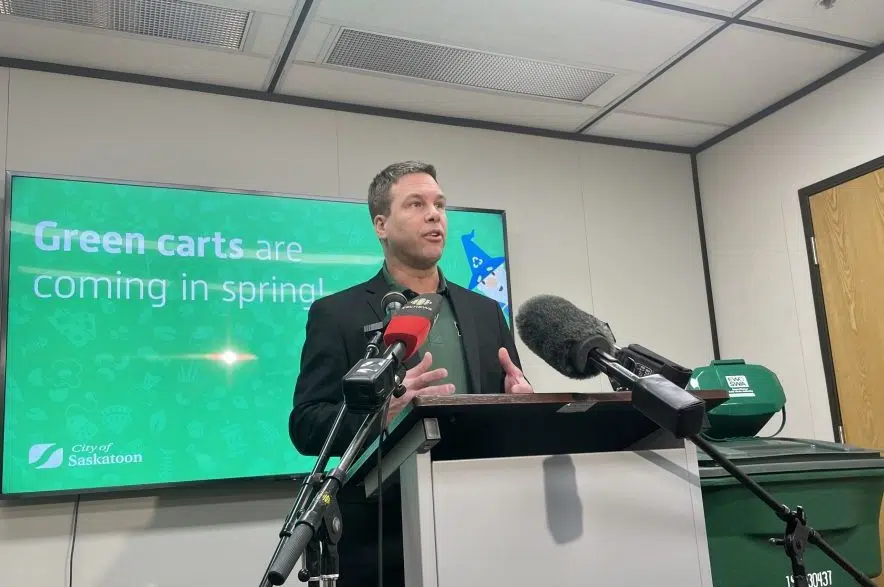In an effort to divert waste from landfills — and avoid having to build a new landfill — the City of Saskatoon is rolling out its green cart program just in time for spring cleanup.
Beginning in mid-March and carrying on through April, households already using the black or blue cart services for garbage and recycling collection will also be getting a green cart to add to their fleet.
Brendan Lemke, director of water and waste operations with the City of Saskatoon, said this change is seen very positively by the city.
Lemke explained that while organic waste is thought to be able to decompose in landfills, buried organics can become compressed underground and, without access to oxygen, may not be able to properly decompose. Those waste products can also release harmful toxins in that state when they are mixed with rainwater.
While that can be managed, Lemke said it is expensive, and hopes the program will be so successful it “may even eliminate the need to replace or build a new landfill at some point.”
He said the city has found that as much as 57 per cent of the waste being put into black carts currently can be composted and is expecting an increase in waste diversion by 14 to 20 per cent.
“A lot of this … depends on how much people use what we’ve offered,” Lemke said. “It comes back to sooner or later, we all have to pay for the waste that we dispose of.”
Waste from yards and kitchens — like lawn clippings, grass, leaves, meat and dairy products — can instead be turned into useful fertilizer by being separated from other waste and composted.

An example of what the City of Saskatoon green carts will resemble as they’re distributed to households in March and April. (Libby Giesbrecht/ 650 CKOM)
While contamination of recycling products has been a concern in the past, Lemke said the green cart program will help — for example, allowing residents to separate the clean part of a pizza box for recycling while putting the soiled portion into the organics waste bin.
Waste bags with BPI certification must be used in the organics bin to ensure everything within the carts is compostable.
Items like car batteries, metals, chemicals, diapers and pet waste can not be disposed of in the organics bins, Lemke said.
“We all have a role to play in this,” Lemke said, noting a multi-unit organics program is in the works but not ready to be implemented yet. The city is also working on a program to educate businesses with lawn and food waste on how to properly dispose of organic waste separately from other waste.
The new program will end the previous green-cart subscription program run by the city but users of that subscription program will be able to continue using the green carts they have and monthly fees will remain roughly the same.
“We’re grateful for those residents … and we’ve seen success in that program,” Lemke said.
The new program is expected to see up to 20,000 tonnes or 3,300 garbage trucks of organic material not go to the landfill over a given year.
The monthly fee for households will be an average of $6.73, added to city utility bills in May when the first bi-weekly collection will occur. The program is a non-revenue one, Lemke said, and the fee being charged will cover costs of composting, collection, maintaining carts and educational materials.
Each household — including those previously enrolled in the subscription program — will receive a kitchen pail along with their large green cart and information on what can and should not be put into the cart.
The carts can be wheeled out to the same location as the black or blue carts on the appropriate collection dates. Black carts will continue to be collected on a bi-weekly basis.
Residents do not have the option to opt in or out of the program.
“We’re all in this together,” Lemke said, noting about 57,000 more residences will now be participating in the green cart program than were in the subscription program at its peak.
Some residents may wonder where they will fit their third bin.
“It’s actually a question I’m asking myself because I need a space for a third bin, too,” Lemke said with a smile.
“When we planned these neighbourhoods, they never had this idea in mind of these three bins being in there,” he continued.
Lemke said residents who need assistance can contact the city but otherwise should use the advance warning provided to make the necessary accommodations.
When the organic waste is collected, it will be taken to a third-party compost facility — Green Prairie Environmental — where composting will happen at a much higher temperature than in a city-owned or backyard composter, Lemke explained.
The ultimate product will be compost meeting the “highest certifications” that can be used as fertilizer for the city and in local yards, gardens and farms.
More information on the green cart program can be found on the city’s website or using the Saskatoon Waste Wizard app.
–Editor’s Note: This story has been updated to correct information about the proper disposal of certain materials.











